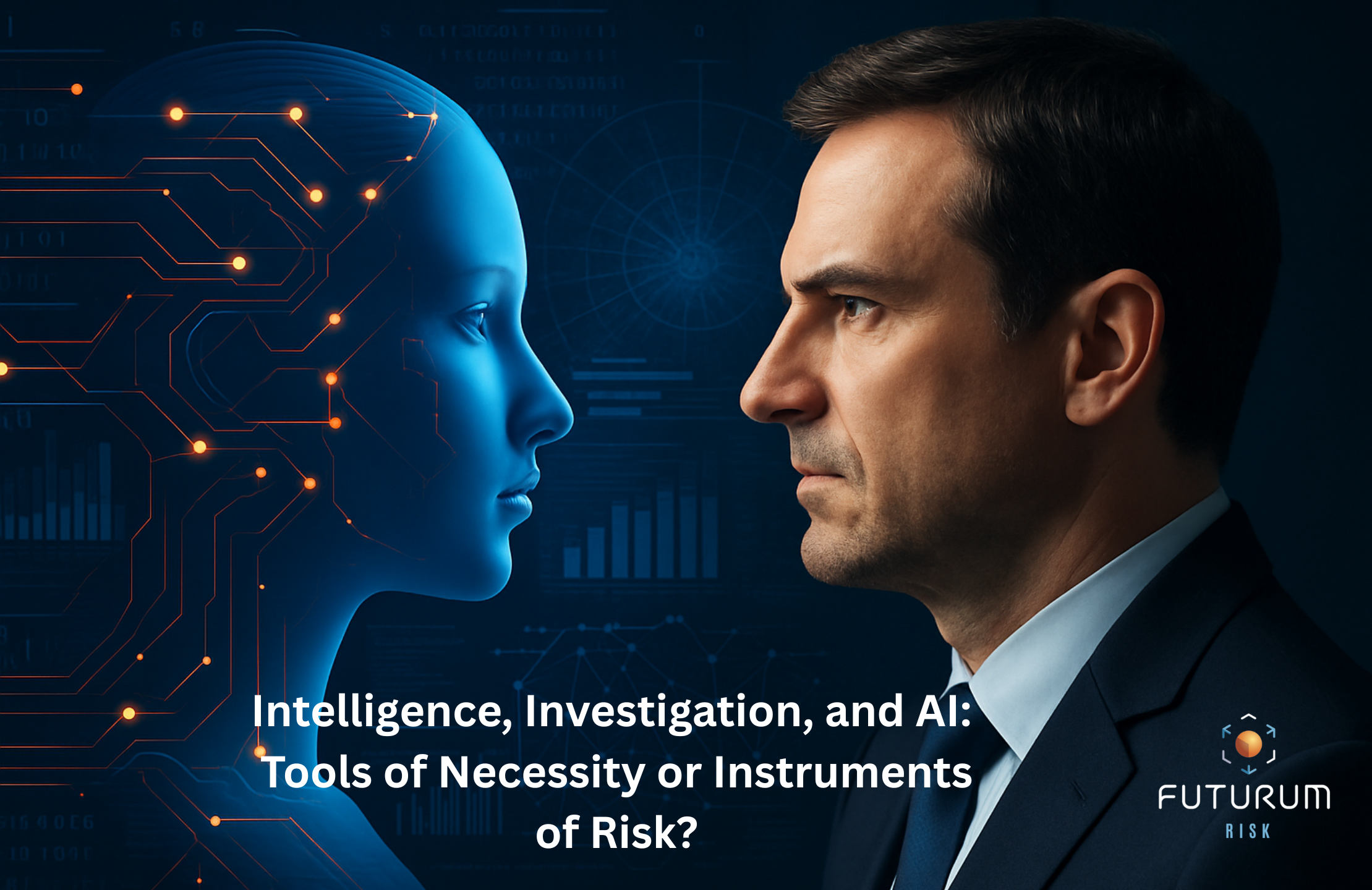The integration of artificial intelligence (AI) into intelligence gathering and investigative analysis is no longer a future possibility; it is the current standard. AI tools have become indispensable to modern investigators and intelligence professionals, enabling everything from online behaviour analysis to the processing of multilingual content at scale. Yet with these advanced capabilities come complex ethical, legal, and operational concerns. The question facing the industry is increasingly urgent: what happens when the very technologies designed to uncover threats begin to introduce new ones?
This article explores the current landscape of AI in the intelligence and investigations sector, unpacking how major players and tools are being used and misused across various operational domains. Drawing from real-world developments and notable technologies, we examine the practical value, limitations, and emerging threats tied to these systems.
The Operational Imperative: Why AI is Now Essential
The intelligence and investigations space is experiencing exponential data overload. Investigators are now expected to analyse not only structured internal reports, but also open-source data streams such as:
- Social media posts in over 100 languages
- Live video and CCTV footage
- Dark web market chatter
- Open government databases and leaks
Traditional manual workflows alone are no longer sufficient to meet the scale and complexity of modern investigations. AI allows for triage, prioritisation, summarisation, and anomaly detection across this diverse data environment. This provides a strategic edge, but it also presents a serious governance challenge when systems act without oversight or contextual understanding.
AI Tools Shaping Investigative Practice
Artificial intelligence continues to reshape how intelligence professionals, investigators, and risk analysts operate across jurisdictions. Below is a critical analysis of key platforms currently in use, along with the operational, legal, and ethical limitations associated with each.
1. Crowlingo: Multilingual Social Media Monitoring
Crowlingo uses natural language processing to scan and analyse open-source web and social media content in over 100 languages. It is designed to surface early indicators of risk, such as hate speech, protest coordination, or reputational threats across different linguistic and cultural contexts.
Risks and Limitations:
- Language models may misread sarcasm, slang, or coded references, leading to misclassification
- Sentiment detection can be unreliable in emotionally charged environments
- Underrepresentation of certain languages or dialects can create blind spots in coverage
- Excessive alerts may reduce efficiency and result in missed genuine risks
- Monitoring activity across borders may raise compliance concerns under local data laws
What starts as mild opportunism, treating the business as a personal asset, can evolve into structural weaknesses. And unless challenged early, this behaviour becomes embedded in corporate culture. At that point, even strong operations may no longer be enough to save the business.
2. Babel Street: Identity and Context Matching
Babel Street performs identity matching by aggregating names, aliases, and context from a range of public and proprietary data sources. It is widely used in border screening, internal threat detection, and reputational risk analysis.
Risks and Limitations:
- Name-based matches can result in false positives and unjustified scrutiny
- Many data sources used do not meet basic standards for consent or transparency
- Overreliance on system output may cause investigators to bypass necessary human checks
- The platform may be used to profile individuals based on digital behaviour or associations
- Limited public visibility of how data is gathered and used increases reputational risk
3. Primer AI: Document Triage at Scale
Primer processes and summarises large volumes of unstructured content such as news reports, legal documents, and internal intelligence. It is used to reduce analyst workload and highlight key relationships and events.
Risks and Limitations:
- Summaries can include hallucinations, where content is fabricated but sounds credible
- Important legal or contextual nuance may be lost in automated processing
- Misinterpretation of summarised data can affect decision-making at critical stages
- Analysts may rely on summaries without referring back to full original sources
- Results depend heavily on the accuracy and completeness of input materials
4. Clearview AI: Facial Recognition and Image Indexing
Clearview AI collects publicly available images from the internet to create a searchable facial recognition database, primarily used by law enforcement and security agencies.
Risks and Limitations:
- Facial recognition systems often show lower accuracy for certain demographics, creating bias
- Use of scraped images without consent breaches data protection laws in many jurisdictions
- Facial recognition has been banned or restricted in several countries due to civil liberties concerns
- The platform can be repurposed for broad surveillance beyond intended use
- Manipulated or misleading images can compromise results and system integrity
5. PimEyes: Facial Search for Public Exposure
PimEyes is a public-facing facial recognition search engine that allows users to upload a photo and locate similar images across the web. Though marketed for privacy monitoring, it has clear investigative and misuse potential.
Risks and Limitations:
- Can be used to track individuals without their knowledge, including vulnerable groups
- The tool has shown more consistent performance when analysing facial features commonly represented in Caucasian datasets, which may affect accuracy across broader demographic groups.
- Search results may link to irrelevant or outdated content, affecting reputations
- The platform does not control or verify how users handle matched information
- The operation relies on scraping practices that raise serious privacy concerns
- Data exposed through matches can contribute to identity fraud and online harassment
Why Human Expertise Remains Essential in AI-Driven Investigations
While these tools offer powerful capabilities across language processing, identity resolution, media verification, and network analysis, they are not substitutes for experienced human investigators. AI can surface patterns, process volume, and automate detection, but it cannot independently assess nuance, intent, or legal relevance.
The risk lies in assuming that output is equivalent to truth. Without contextual judgment, ethical oversight, and investigative discipline, even the most advanced platforms can generate flawed or misleading results. Human expertise remains critical to interpreting findings, validating claims, and ensuring that intelligence leads to sound action rather than operational risk.
Building Strong AI Governance in Investigative Contexts
As artificial intelligence becomes embedded in the daily operations of intelligence and investigative teams, organisations must elevate their standards for control, accountability, and ethical oversight. Technology should enhance operational outcomes, not bypass judgment or due process. Without good governance, the very systems designed to increase insight and efficiency can introduce legal, reputational, and security risks.
Futurum Risk recommends the following safeguards as foundational to any responsible AI deployment in investigative settings:
1. Human Oversight
All AI-generated outputs, including flagged content, entity matches, document summaries, and risk classifications, must be verified by trained analysts before any operational or legal action is taken. AI should support decision-making, not replace it. Human investigators remain essential for interpreting context, identifying errors, and ensuring a measured, defensible response.
2. Bias Testing and Diversity Auditing
All AI systems used in investigations must be routinely tested for demographic, linguistic, and cultural bias. This includes third-party tools, in-house models, and vendor platforms. Bias audits must not be treated as optional or ethical add-ons. They should be integrated into core operational controls to prevent the reinforcement of flawed or discriminatory outcomes.
3. Defined Use Policies and Legal Vetting
Organisations must clearly define which AI tools are used, for what purpose, and under what conditions. Each use case must be reviewed through a legal and regulatory lens, with explicit guidelines governing access, data handling, and jurisdictional compliance. Open-ended or unchecked use of facial recognition, social media monitoring, or biometric profiling should be avoided in favor of access frameworks that reflect proportionality and legal necessity.
4. Countermeasures for Deepfakes and Manipulated Media
Given the rising threat of synthetic media in fraud, disinformation, and reputational attacks, investigative teams should invest in robust detection capabilities. This includes tools for forensic video analysis, cryptographic watermarking, and adversarial AI models designed to identify audio or visual manipulation. Detection should form part of every media authentication workflow.
5. Auditability, Logging, and Transparency
Every AI-driven decision or recommendation must be auditable. Systems should record inputs, processing logic, user interactions, and outputs. Logs must be accessible for compliance reviews, investigations, and legal challenges. Transparent audit trails are essential for institutional accountability, especially where AI outputs inform legal or financial risk decisions.
A Dual-Edged Transformation
Artificial intelligence is reshaping the way intelligence and investigative work are conducted. It allows practitioners to uncover risks that would otherwise remain hidden, process vast amounts of diverse data, and respond with speed and scale that manual workflows cannot match. Yet the same tools that deliver these advantages can also introduce new forms of risk.
AI systems are capable of producing valuable insights, but also deception, bias, and flawed conclusions. These risks may emerge through poor data quality, unvalidated automation, or weak policy frameworks. In high-stakes environments, such outcomes can have serious legal and operational consequences. AI is not a neutral instrument. It must be applied with discipline, context, and clear accountability.
This is where Futurum Risk plays a critical role. Our work goes beyond the adoption of technology. We ensure that AI is used responsibly, in line with legal requirements and strategic intent. Our team includes experienced investigators, analysts, and OSINT professionals who bring human judgment into every stage of the process. They interpret outputs, verify findings, and ensure that intelligence supports sound decisions, not assumptions.
At Futurum, we help clients apply AI in ways that are effective, ethical, and defensible. In the field of intelligence, integrity is not optional. It is essential for every outcome that matters. As the role of AI grows, so too must our commitment to ensuring it serves as a tool for clarity, not confusion.





